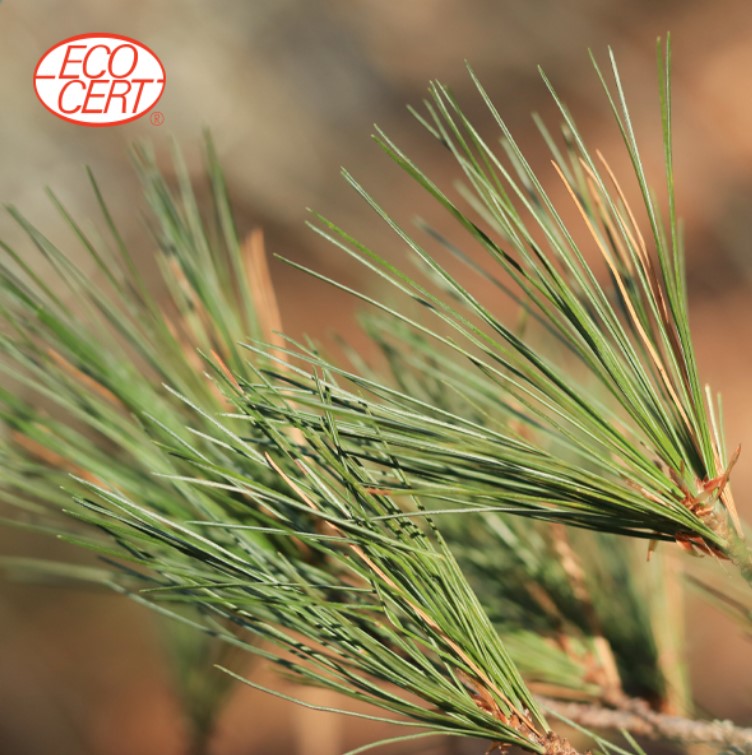Product Description
Latin Name: Pinus strobus
French Name: Pin Blanc
English Name: White Pine
Botanical Family Name: Pinaceae
Origin: Quebec, Canada
Distilled Parts: Branches and needles
Organoleptic Specificities: Balsamic, fruity, green, woody, clear to light yellow
Main Components of the Essential Oil Part: α- β pinene, myrcene, limonene, camphene, β-Phellandrene
ORIGIN
The White Pine is one of the four native species of pine in Quebec and can reach up to 35 meters in height. However, individual trees have already been known in the past to reach as high as 90 meters, competing with the tallest trees in the American West. Today, the territory of the White Pine extends from southern Quebec to Abitibi in the north. Its prosperity is favored by sandy, wet or clay soils allowing it to live up to 200 years or longer. Fast growing, this tree is shaped throughout its life by the prevailing winds, often giving it an asymmetrical appearance.
At the beginning of its life, the bark of the White Pine has a smooth appearance and is grayish green in color. As the tree matures, deep furrows form on the bark, which become dark greyish-brown over time. The tree is easily recognizable by its soft and thin needles that form in clusters of 5. The clusters measure from 6 to 13 cm in length and remain attached to the tree over a period of 1 to 4 years. Being vulnerable to fire because of its thin bark, White Pines generally live alongside other tree species, such as Spruces.
The elongated and slightly curved cones measure between 8 and 20 cm in length. Reproductive seeds only appear after about 30 years. Cones start to form and hang from the tree in July during the second growing season and only open during the winter.
HISTORY
In the 19th century, settlers from Europe chose the White Pine, because its height exceeded other surrounding tree species. They mainly used it for the construction of houses, boats, masts or sailboats. This intense exploitation of the natural White Pine forests reduced their area by 2 to 3%.
The White Pine was thus instrumental in the establishment of European settlers in North America. Nevertheless, this tree represents a genuine symbol of peace for Native Americans and its cluster of 5 needles are a symbol of unity. Beyond this symbolism, Amerindians also used this tree for its health benefits, notably to fight colds or to heal wounds.
BENEFITS
White Pine essential oil, like Black Spruce, Scots Pine or Balsam Fir, increases energy metabolism and stimulates the organism. It is particularly useful in stopping the evolution of a cold, to tone the adrenals, and to relieve rheumatism and joint pain thanks to its high rate of α and β pinene: anti-inflammatory +++. In diffusion, it is a good antiseptic for the air with a comforting balsamic scent. It helps to relieve stress and depression.
PHYSICAL
Circulatory system: Lymphotonic.
Endocrine system: Mimetic cortisone by modulating effect on the adrenals and also influences the S.N.A. with a targeted action on the smooth muscles of different organs, balancing, toning the adrenals+++.
Immune system: Antibacterial, winter antiseptic, antiviral, antiparasitic, vermifuge.
Respiratory system: Pulmonary decongestant by exocrinostimulant and lymphotonic action, bronchial antispasmodic.
Nervous system: Analgesic, stimulating brain irrigation, relaxing: promotes sleep, antispasmodic, calms the abdominal brain and central nervous system.
Osteo-articular system: Anti-inflammatory, analgesic, painkiller, decongestant, anti- arthritic+.
PSYCHIC
Psycho toning
Increases concentration capacity
Promotes logical reasoning
Stimulates the mind
Increases psychic resistance
Uses: rhinitis, bronchitis, sinusitis, cold, dyspnea, digestive, osteoarthritis +, cellulitis, cramps, muscle pain, fatigue, asthenia, purifies the air.
Contra-indications: None, at physiological doses. Essential conifer oils can irritate the skin if they are oxidized.
Recommendations: Essential oils are wonderful for the well-being of humans, animals, insects and plants. There are many books on the subject of aromatherapy and they should be referred to for the proper and safe use of essential oils. We also recommend that you consult an aromatherapy professional, who will be able to target the aromatic molecules of essential oils and their biochemical groupings, thereby increasing the effectiveness of your care.
We recommended you store essential oils in a cool, dry place, away from light and air.
